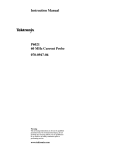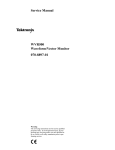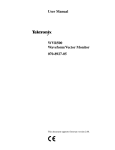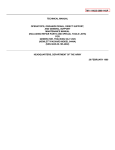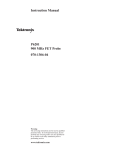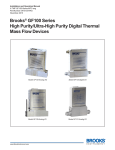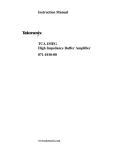Download Instruction Manual P6021 60 MHz Current Probe
Transcript
Instruction Manual P6021 60 MHz Current Probe 070-0947-05 Warning The servicing instructions are for use by qualified personnel only. To avoid personal injury, do not perform any servicing unless you are qualified to do so. Refer to all safety summaries prior to performing service. www.tektronix.com Copyright © Tektronix, Inc. All rights reserved. Tektronix products are covered by U.S. and foreign patents, issued and pending. Information in this publication supercedes that in all previously published material. Specifications and price change privileges reserved. Tektronix, Inc., P.O. Box 500, Beaverton, OR 97077 TEKTRONIX and TEK are registered trademarks of Tektronix, Inc. LUBRIPLATE is a registered trademark of the Fiske Brothers Refining Co. POSIDRIV is a registered trademark of the Philips Screw Co. WARRANTY Tektronix warrants that this product will be free from defects in materials and workmanship for a period of one (1) year from the date of shipment. If any such product proves defective during this warranty period, Tektronix, at its option, either will repair the defective product without charge for parts and labor, or will provide a replacement in exchange for the defective product. In order to obtain service under this warranty, Customer must notify Tektronix of the defect before the expiration of the warranty period and make suitable arrangements for the performance of service. Customer shall be responsible for packaging and shipping the defective product to the service center designated by Tektronix, with shipping charges prepaid. Tektronix shall pay for the return of the product to Customer if the shipment is to a location within the country in which the Tektronix service center is located. Customer shall be responsible for paying all shipping charges, duties, taxes, and any other charges for products returned to any other locations. This warranty shall not apply to any defect, failure or damage caused by improper use or improper or inadequate maintenance and care. Tektronix shall not be obligated to furnish service under this warranty a) to repair damage resulting from attempts by personnel other than Tektronix representatives to install, repair or service the product; b) to repair damage resulting from improper use or connection to incompatible equipment; or c) to service a product that has been modified or integrated with other products when the effect of such modification or integration increases the time or difficulty of servicing the product. THIS WARRANTY IS GIVEN BY TEKTRONIX WITH RESPECT TO THIS PRODUCT IN LIEU OF ANY OTHER WARRANTIES, EXPRESSED OR IMPLIED. TEKTRONIX AND ITS VENDORS DISCLAIM ANY IMPLIED WARRANTIES OF MERCHANTABILITY OR FITNESS FOR A PARTICULAR PURPOSE. TEKTRONIX’ RESPONSIBILITY TO REPAIR OR REPLACE DEFECTIVE PRODUCTS IS THE SOLE AND EXCLUSIVE REMEDY PROVIDED TO THE CUSTOMER FOR BREACH OF THIS WARRANTY. TEKTRONIX AND ITS VENDORS WILL NOT BE LIABLE FOR ANY INDIRECT, SPECIAL, INCIDENTAL, OR CONSEQUENTIAL DAMAGES IRRESPECTIVE OF WHETHER TEKTRONIX OR THE VENDOR HAS ADVANCE NOTICE OF THE POSSIBILITY OF SUCH DAMAGES. Table of Contents P6021 Instruction Manual General Safety Summary . . . . . . . . . . . . . . . . . . . . . . . . . . . . . . . . . . . . Service Safety Summary . . . . . . . . . . . . . . . . . . . . . . . . . . . . . . . . . . . . . Contacting Tektronix . . . . . . . . . . . . . . . . . . . . . . . . . . . . . . . . . . . . . . . Operator Information . . . . . . . . . . . . . . . . . . . . . . . . . . . . . . . . . . . . . . . iii v vi 1 Description . . . . . . . . . . . . . . . . . . . . . . . . . . . . . . . . . . . . . . . . . . . . . . . . . . . . . . Installation . . . . . . . . . . . . . . . . . . . . . . . . . . . . . . . . . . . . . . . . . . . . . . . . . . . . . . Operating Considerations . . . . . . . . . . . . . . . . . . . . . . . . . . . . . . . . . . . . . . . . . . . 1 1 4 Service Information . . . . . . . . . . . . . . . . . . . . . . . . . . . . . . . . . . . . . . . . . 7 Warranted Characteristics . . . . . . . . . . . . . . . . . . . . . . . . . . . . . . . . . . . . . . . . . . Typical Characteristics . . . . . . . . . . . . . . . . . . . . . . . . . . . . . . . . . . . . . . . . . . . . . Circuit Description . . . . . . . . . . . . . . . . . . . . . . . . . . . . . . . . . . . . . . . . . . . . . . . . Performance Verification . . . . . . . . . . . . . . . . . . . . . . . . . . . . . . . . . . . . . . . . . . . Adjustment Procedures . . . . . . . . . . . . . . . . . . . . . . . . . . . . . . . . . . . . . . . . . . . . Maintenance . . . . . . . . . . . . . . . . . . . . . . . . . . . . . . . . . . . . . . . . . . . . . . . . . . . . . 7 10 12 14 16 26 Replaceable Electrical Parts . . . . . . . . . . . . . . . . . . . . . . . . . . . . . . . . . . 31 Parts Ordering Information . . . . . . . . . . . . . . . . . . . . . . . . . . . . . . . . . . . . . . . . . Using the Replaceable Electrical Parts List . . . . . . . . . . . . . . . . . . . . . . . . . . . . . 31 31 Replaceable Mechanical Parts . . . . . . . . . . . . . . . . . . . . . . . . . . . . . . . . 37 Parts Ordering Information . . . . . . . . . . . . . . . . . . . . . . . . . . . . . . . . . . . . . . . . . Using the Replaceable Mechanical Parts List . . . . . . . . . . . . . . . . . . . . . . . . . . . 37 37 Index . . . . . . . . . . . . . . . . . . . . . . . . . . . . . . . . . . . . . . . . . . . . . . . . . . . . . 43 i Table of Contents List of Figures Figure 1: The P6021 Probe and Termination . . . . . . . . . . . . . . . . . . . . Figure 2: Insertion Impedance of the P6021 . . . . . . . . . . . . . . . . . . . . . Figure 3: Probe and Termination Input Current vs. Frequency Derating . . . . . . . . . . . . . . . . . . . . . . . . . . . . . . . . . . . . . Figure 4: Typical P6021 Phase Response . . . . . . . . . . . . . . . . . . . . . . . Figure 5: P6021 Schematic Diagram . . . . . . . . . . . . . . . . . . . . . . . . . . . Figure 6: Connecting the Probe to the Calibration Fixture . . . . . . . . Figure 7: Location of Probe Adjustments . . . . . . . . . . . . . . . . . . . . . . . Figure 8: Location of Termination Adjustments . . . . . . . . . . . . . . . . . Figure 9: Disassembling the Probe . . . . . . . . . . . . . . . . . . . . . . . . . . . . Figure 10: P6021 Probe Component Location . . . . . . . . . . . . . . . . . . . Figure 11: P6021 Termination Component Location . . . . . . . . . . . . . . Figure 12: P6021 Exploded View . . . . . . . . . . . . . . . . . . . . . . . . . . . . . 2 5 9 11 13 18 19 20 27 35 35 41 Table 1: Warranted Electrical Characteristics . . . . . . . . . . . . . . . . . . Table 2: Warranted Environmental Characteristics . . . . . . . . . . . . . . Table 3: Maximum Ratings . . . . . . . . . . . . . . . . . . . . . . . . . . . . . . . . . . Table 4: Certifications and Compliances . . . . . . . . . . . . . . . . . . . . . . . Table 5: Electrical Characteristics . . . . . . . . . . . . . . . . . . . . . . . . . . . . Table 6: Mechanical Characteristics . . . . . . . . . . . . . . . . . . . . . . . . . . . Table 7: Equipment List . . . . . . . . . . . . . . . . . . . . . . . . . . . . . . . . . . . . 7 8 8 9 10 11 15 List of Tables ii P6021 Instruction Manual General Safety Summary Review the following safety precautions to avoid injury and prevent damage to this product or any products connected to it. To avoid potential hazards, use this product only as specified. Only qualified personnel should perform service procedures. To Avoid Fire or Personal Injury Connect and Disconnect Properly. Do not connect or disconnect probes or test leads while they are connected to a voltage source. Observe All Terminal Ratings. To avoid fire or shock hazard, observe all ratings and markings on the product. Consult the product manual for further ratings information before making connections to the product. Connect the ground lead of the probe to earth ground only. Do not apply a potential to any terminal, including the common terminal, that exceeds the maximum rating of that terminal. Do Not Operate Without Covers. Do not operate this product with covers or panels removed. Avoid Exposed Circuitry. Do not touch exposed connections and components when power is present. Do Not Operate With Suspected Failures. If you suspect there is damage to this product, have it inspected by qualified service personnel. Do Not Operate in Wet/Damp Conditions. Do Not Operate in an Explosive Atmosphere. Keep Product Surfaces Clean and Dry. P6021 Instruction Manual iii General Safety Summary Symbols and Terms Terms in this Manual. These terms may appear in this manual: WARNING. Warning statements identify conditions or practices that could result in injury or loss of life. CAUTION. Caution statements identify conditions or practices that could result in damage to this product or other property. Terms on the Product. These terms may appear on the product: DANGER indicates an injury hazard immediately accessible as you read the marking. WARNING indicates an injury hazard not immediately accessible as you read the marking. CAUTION indicates a hazard to property including the product. Symbols on the Product. The following symbols may appear on the product: CAUTION Refer to Manual iv Double Insulated Protective Ground (Earth) Terminal P6021 Instruction Manual Service Safety Summary Only qualified personnel should perform service procedures. Read this Service Safety Summary and the General Safety Summary before performing any service procedures. Do Not Service Alone. Do not perform internal service or adjustments of this product unless another person capable of rendering first aid and resuscitation is present. To avoid electric shock, do not touch exposed connections. P6021 Instruction Manual v Contacting Tektronix Contacting Tektronix Phone 1-800-833-9200* Address Tektronix, Inc. Department or name (if known) 14200 SW Karl Braun Drive P.O. Box 500 Beaverton, OR 97077 USA Web site www.tektronix.com Sales support 1-800-833-9200, select option 1* Service support 1-800-833-9200, select option 2* Technical support Email: [email protected] 1-800-833-9200, select option 3* 1-503-627-2400 6:00 a.m. – 5:00 p.m. Pacific time * vi This phone number is toll free in North America. After office hours, please leave a voice mail message. Outside North America, contact a Tektronix sales office or distributor; see the Tektronix web site for a list of offices. P6021 Instruction Manual Operator Information Thank you for choosing a Tektronix current probe. This manual describes the P6021 current probe with passive termination and provides information about making measurements with the probe. Description The P6021 current probe converts an alternating current waveform to a voltage that can be displayed and measured on an oscilloscope display. The probe provides accurate current measurements over a wide range of frequencies and allows you to measure current without breaking the circuit. The P6021 probe is compatible with general purpose oscilloscopes having a 1 M input impedance. The P6021 probe comes with a passive termination that matches oscilloscope and probe impedance, optimizes the probe performance, and provides two sensitivity settings. W In the standard configuration, the P6021 probe comes with a 5-foot cable and termination. The following option is also available. Option 03. 9-foot cable with termination Installation This section describes both attaching the probe to an oscilloscope and using the standard accessories with the probe. To ensure the best performance from your probe and oscilloscope measurement system, check that the probe and oscilloscope are appropriately matched. The oscilloscope inputs should use BNC connectors and have an impedance of 1M . W Figure 1 shows the probe and various parts referred to in this manual. P6021 Instruction Manual 1 Operator Information P6021 Probe Termination 6" Ground Lead Figure 1: The P6021 Probe and termination Attaching the Probe and Termination to an Oscilloscope Attach the probe to the termination as shown in Figure 1. An alligator-style ground clip is supplied to improve EMI rejection at high frequencies (2 MHz and above). Snap the ground lead to the probe transformer post and attach the alligator clip directly to RF ground. This will reduce ringing and help bypass capacitively-coupled RF currents that can flow into the probe cable. WARNING. To avoid injury or equipment damage, remove power from an uninsulated wire before clamping the current probe around it. When the probe slides are open, the exposed ferrite core pieces are not insulated. Also, never disconnect the probe from the termination when the probe is connected to a live conductor. To avoid damaging the probe, do not disconnect the probe termination and leave the P6021 clamped around the conductor when measuring high currents. Leaving the probe cable unterminated can cause a high voltage to develop in the secondary winding, which may damage the current probe transformer. 2 P6021 Instruction Manual Operator Information Using the Standard Accessories Your P6021 is shipped with the following accessories: H This instruction manual — Read these instructions to familiarize yourself with the features, specifications, and operation of the P6021 current probe. H 6-inch ground lead — Use the 6-inch ground lead to ground the shield around the probe transformer at the probe end of the cable. This allows you to move the ground connection closer to the circuit that you are measuring, thereby improving high frequency response. The ground lead clips onto the ground connector on the bottom of the probe as shown. Please refer to the parts list in the section entitled Replaceable Mechanical Parts for part numbers. Optional Accessories Your P6021 may be used with the following optional accessory: H CT-4 Current Probe — The CT-4 is a robust clip-on transformer that extends the current range of the P6021 up to 1000 amps (provided the amp-second rating is not exceeded). The CT-4 has receptacles for current probes in either 20:1 or 1000:1 step-down ratios. P6021 Instruction Manual 3 Operator Information Operating Considerations The information in this section will help you make effective use of your P6021 probe. Features and Controls H Sensitivity Control — The P6021 termination has a control that allows you to select probe sensitivity. The switch has two positions: 2 mA/mV and 10 mA/mV. When the control is in the 2 mA/mV position, the oscilloscope displays 1 mV for every 2 mA of current in the circuit under test. When the control is in the 10 mA/mV position, the oscilloscope displays 1 mV for every 10 mA of current in the circuit under test. Sensitivity control You can set vertical scale on the oscilloscope to any scale factor, as determined by the signal amplitude. To calculate the overall vertical scale factor for the oscilloscope, probe, and termination, multiply the termination sensitivity control setting by the vertical scale factor of the oscilloscope. For example, if the termination control is set to the 10 mA/mV position and the oscilloscope to a vertical scale of 20 mV/division, the overall scale factor is 10 X 20, or 200 mA/division. H Probe Slide Switch — The slide switch on the probe has three positions: Open Closed Locked Probe slide switch Ridge open, closed, and locked. Use your thumb to move the probe slide switch. The switch is spring loaded so that it automatically moves from the open to closed positions. To Use the Probe: a. Pull the slide switch toward you, and hold the switch in position. b. Place the conductor-under-test inside the exposed transformer core. The arrow on the transformer end of the probe indicates conventional current flow. If you place the probe on the conductor so that the arrow on the probe matches conventional current flow through the conductor, orientation of the displayed waveform will be correct. c. Release the switch, allowing the probe to close. d. Lock the slide switch. To lock the switch, push it firmly toward the transformer (the switch will move only about 1/8th inch). Locking the switch assures maximum contact between the two halves of the transformer secondary. The conductor now becomes the primary of the transformer. (When measuring current, always check that the probe slide switch is moved completely forward into the locked position.) WARNING. To prevent shock when measuring uninsulated conductors, keep your hands and fingers behind the ridge on the probe head. 4 P6021 Instruction Manual Operator Information Insertion Impedance When you insert a conductor into the probe, you add impedance to the circuit you are measuring. This additional impedance affects signals; this is particularly important if you are measuring fast rise times. Figure 2 illustrates the equivalent circuit with the additional impedance introduced by the P6021. 2.8 m H .004 1.7 nH W Figure 2: Insertion Impedance of the P6021 Minimizing Loading Effect To minimize the loading effect of the probe, clamp it at the low or ground end of a component lead when possible. This method also minimizes noise or stray signal interference. Increasing Probe Sensitivity You can increase the current sensitivity of the probe by increasing the number of times a conductor passes through it. For example, if the conductor loops through the probe twice (a two-turn primary winding), the secondary current is doubled. For example, suppose you set the termination sensitivity to 2 mA/mV and the oscilloscope vertical scale to 10 mV/division. Ordinarily, this would result in the equivalent of 2 X 10, or 20 mA/division. However, if the conductor is looped through the probe twice, the vertical scale is divided by two, resulting in the equivalent of 10 mA/division. Looping the conductor twice effectively doubles vertical sensitivity; however, impedance from the probe winding is also reflected into the circuit being measured. This impedance is proportional to the square of the number of loops. This additional impedance affects signals; this impedance is particularly important when you are measuring high-frequency current waveforms or waveforms with fast rise times. P6021 Instruction Manual 5 Operator Information Probe Shielding The P6021 is shielded to minimize the effect of external magnetic fields. However, strong fields can interfere with the current signal being measured. If you suspect that an external field is interfering with your measurement, remove the probe from the conductor, but keep it in the same location as when you made the suspect measurement. If a signal still appears on the oscilloscope, try to measure the conductor current at a point farther from the location of the magnetic field. If you must measure current in the presence of a strong magnetic field, you can minimize its interference by using two current probes and a differential-input oscilloscope. To do so, follow these steps. 1. Connect the probes (with termination) to the positive and negative inputs of the oscilloscope. 2. Clamp one probe around the conductor whose current you want to measure. 3. Place the other probe as close as possible to the first. Ensure that its slide switch is completely closed, without a conductor inside it. 4. Set the oscilloscope to subtract the component of the signal that is common to both probes. 5. Adjust the positions of the probes for best results. It may be difficult to eliminate the undesirable signal completely, due to differences between the probes or their terminations. Droop The flat-top response of any AC current probe displays a certain amount of droop. This is caused by probe inductance loading the source impedance, causing an L/R exponential decay. For short pulse widths, the response looks nearly flat. The amount of droop can be calculated from the following relationship: % Droop = 200 (p) T f where: T=pulse duration in microseconds f=lower 3 dB frequency of probe in Hertz For example, to calculate the percent droop of a 100 ms pulse measured with a P6021 probe: In the 10 mA/mV position, f=120 Hz % Droop = 200 (p) T f = 200 (p) (100*10–6) (120) = 0.075% 6 P6021 Instruction Manual Service Information Warranted Characteristics This section lists the various warranted characteristics that describe the P6021 Current Probe. Included are warranted electrical and environmental characteristics. Warranted characteristics are described in terms of quantifiable performance limits which are warranted. The electrical characteristics listed in Table 1 apply under the following conditions: H The probe and instrument must be in an environment whose limits are described in Table 2. Table 1: Warranted electrical characteristics Characteristic Information Sensitivity 2 mA or 10 mA for each mV at oscilloscope input, selected by termination sensitivity control Midband Accuracy ±3% at 10 kHz to 30 kHz System Bandwidth (with BW>200 MHz oscilloscope) 2 mA/mV 450 Hz to 60 MHz 10 mA/mV 120 Hz to 60 MHz Probe Rise Time ≤5.8 ns Step Response Because the oscilloscope input capacitance becomes a part of the termination network, the step response will vary with different oscilloscopes Aberrations (probe and termination at either sensitivity setting.) P6021 Instruction Manual ≤10% peak-to-peak within 50 ns of step; ≤2% peak-to-peak thereafter 7 Service Information Table 2: Warranted environmental characteristics Characteristic Information Temperature range Operating –0_C to +50_C (+32_F to +122_F) Nonoperating –40_C to +65_C (–40_F to +149_F) Altitude Operating To 2,000 m (6,561 ft), <300 V CAT I To 4,572 m (15,000 ft), <150 V, CAT I Nonoperating To 15,240 m (50,000 ft) Table 3: Maximum ratings 8 Characteristic Information Maximum Continuous (CW) Current Refer to Figure 3 for frequency derating curves 2 mA/mV 5 Ap-p sine wave between 1.2 kHz and 5 MHz 10 mA/mV 15 Ap-p sine wave between 300 Hz and 5 MHz Maximum Pulse Current 250 A peak, not to exceed 500(A · ms) or 5 ARMS. An (A · s) product greater than 500(A · ms) reduces probe output to zero due to core saturation Maximum Working Input Voltage (uninsulated conductors) 300 VAC or VDC, CAT I, and 600 Vpk limited to <10 ms and <25% duty factor. P6021 Instruction Manual Service Information 100 A 10mA/mV 20 A 10 A 2 mA/mV AMPS PĆP 1 A 0.1A 10 Hz 100 Hz 1 kHz 1 MHz 10 MHz 100 MHz FREQUENCY Figure 3: Probe and termination input current vs. frequency derating Table 4: Certifications and compliances EC Declaration of Conformity – Low Voltage Compliance was demonstrated to the following specifications as listed in the Official Journal of the European Communities: Low Voltage Directive 73/23/EEC, as amended by 93/68/EEC P6021 Instruction Manual EN 61010-1/A2 Part 1: General Requirements Safety requirements for electrical equipment for measurement, control, and laboratory test EN 61010-2-032:1995 Part 2-032: Particular requirements for hand-held current clamps for electrical measurements and test Listed UL1244, Third Edition Electrical and electronic measuring and test equipment 9 Service Information Table 4: Certifications and compliances (Cont.) Installation Category Descriptions Terminals on this product may have different installation category designations. The installation categories are: CAT III Distribution-level mains (usually permanently connected). Equipment at this level is typically in a fixed industrial location CAT II Local-level mains (wall sockets). Equipment at this level includes appliances, portable tools, and similar products. Equipment is usually cord-connected CAT I Secondary (signal level) or battery operated circuits of electronic equipment Pollution Degree 2 Do not operate in environments where conductive pollutants may be present. Typical Characteristics This section lists the various typical characteristics that describe the P6021 Current Probe. Included are typical electrical and mechanical characteristics. Typical characteristics are described in terms of typical or average performance. Typical characteristics are not warranted. Table 5: Electrical characteristics Characteristic Information Tilt 2 mA/mV 2.8% or less within 10 ms of step 10 mA/mV 7.5% or less within 100 ms of step Maximum DC saturation 0.5 A Signal Delay 5-foot probe with termination Approximately 9 ns 9-foot probe with termination Approximately 15.8 ns Insertion Impedance 10 0.03 W or less at 1 MHz, increasing to 1.0 W or less at 60 MHz P6021 Instruction Manual Service Information Table 6: Mechanical characteristics Characteristic Information Probe Cable Length 5 ft or 9 ft 1.5 m or 2.75 m Probe and 5-foot cable 3.60 oz ≈103 gm Probe and 9-foot cable 4.4 oz ≈125 gm Termination 1.7 oz ≈48 gm Net Weight: Termination L W H 3.47 in 1.10 in 0.86 in 88 mm 28 mm 22 mm Probe Body L W H 7.9 in 0.63 in 1.25 in 200 mm 16 mm 32 mm Maximum Conductor Diameter 0.141 in 3.58 mm Frequency 100 100 Hz 1 kHz 10 kHz 100 kHz 1 MHz 10 MHz 100 MHz 50 Degrees 0 -50 -100 -150 Termination at 10 mA Termination at 2 mA -200 Figure 4: Typical P6021 phase response P6021 Instruction Manual 11 Service Information Circuit Description This section describes the circuits in the P6021 current probe and termination. For the schematic diagram of the probe and termination, see Figure 5 on page 13. Current Probe The P6021 current probe consists of a current transformer mounted in the nose of the probe head case, an impedance-matching network, and an internal switch to disconnect the transformer shield from ground. The transformer contains a two-section U-shaped ferrite core. One section is stationary; the other is mechanically movable to permit closing the core around the conductor being measured. The conductor under test forms a one-turn primary winding for the transformer; the windings around the stationary portion of the core are the secondary windings. Paralleled windings in the secondary assure a fast step response. The circuitry between the transformer and the coaxial cable corrects any differences in level between the signal induced in the parallel windings of the secondary and matches the balanced probe winding to the cable. As indicated on the probe body, the turns ratio of the P6021 is 125:1. This refers to the number of windings in the secondary of the probe transformer. The probe transformer is shielded to eliminate interference from outside signals. To eliminate the possibility of creating a short circuit from this shield to the conductor being measured, the slide switch disconnects the ground from the shield when you open the sliding portion of the probe to connect or remove it from a conductor. Termination W The P6021 termination consists of a 62.5 impedance-matching network to terminate the coaxial cable and a voltage divider that is switched in by a sensitivity control to change the sensitivity by a factor of five. When the control is in the 2 mA/mV position, a 10 mA current signal in the conductor under test induces a 5 mV signal at the output of the termination. (This assumes that the termination is connected to a 1 M input oscilloscope.) W When the sensitivity control is in the 10 mA/mV position, a 10 mA current signal is attenuated to induce a 1 mV signal at the output of the termination. 12 P6021 Instruction Manual Service Information MECHANICALLY LINKED SW30 SPRING RETURN TO NORMALLY CLOSED POSITION FERRITE TRANSFORMER CORE 2mA/mV SW20 L14 1.6 H m R10 1K T1 L10 50 H m R13 820 R12 1K T14 W20 L22 R22 100 R14 120 C14 51 L12 50 H m (6T) C22 5-25 ADDED AFTER 1249 R36 200 (3T) J20 HF COMP R24 61.9 10mA/mV P39 C25 5-25 R35 24 L31 64 H m C13 2.5-9 C30 4.7 R31 51.1 R33 24.9 R34 24.3 SHIELD P6021 PROBE P6021 PASSIVE TERMINATION Figure 5: P6021 schematic diagram P6021 Instruction Manual 13 Service Information Performance Verification WARNING. To avoid personal injury and damage to the probe, remove the probe from any signal source before attempting to adjust or service the probe. This probe should be serviced only by qualified service personnel. Do not service electrical equipment alone. If you must service or adjust equipment that is attached to a signal or power source, do so only when another person capable of rendering first aid and resuscitation is present. This section provides procedures to check the performance of the P6021 or to calibrate it. These procedures require the equipment listed in Table 7. Specifications given are the minimum necessary for accuracy. If equipment is substituted, it must meet or exceed the specifications of the recommended equipment. Test equipment is assumed to be correctly calibrated and operating within the given specifications. Also, if equipment is substituted, control settings or equipment setup may need to be altered. For detailed operating instructions for the test equipment, refer to the instruction manual for each unit. To ensure measurement accuracy, check the performance of the probe and termination whenever you begin using them with a different oscilloscope input, especially when you have changed input capacitance. Recalibrate the probe if necessary. The recommended calibration interval of the probe and termination is every twelve months. Before calibrating the probe, thoroughly inspect and clean it as described in the section entitled Maintenance. Dirty or worn mating surfaces between the transformer and the lid can degrade low-frequency response. Clean these surfaces if necessary. Calibration procedures can also be used as performance checks by completing all steps except those that adjust the probe. This checks the probe and termination to the original performance standards without requiring you to remove the termination cover or make internal adjustments. 14 P6021 Instruction Manual Service Information Table 7: Equipment list Item Description Oscilloscope Recommended equipment1 TDS 420A, TDS 303X, or TDS 305X Bandwidth DC to ≥200 MHz Vertical sensitivity 1 mV/div Measurement functions Amplitude, pk-pk, gated measurements, averaging Calibration generator Fast rise step ≤1 ns, 1 VP-P into 50 W Wavetek 9100 with option 100:250 or Tektronix PG 506A Sinewave current 0.5 AP-P to 15 AP-P, 120 Hz to 10 kHz, ≤ ±0.60% Wavetek 9100 0.9 AP-P, 30 kHz, ≤ ±0.60% Sinewave voltage Digital Multimeter (DMM) RMS ACV 5 VP-P into 50 W (100 mA), 50 kHz to >60 MHz, 1.5% flatness Wavetek 9100 with option 100:250, Tektronix SG 5030, SG 503 5 1/2 digits or better Keithley 2000, HP 3458A 50 mV to 1.0 V, 10 kHz, ≤ ±0.35% 30 mV to 160 mV, 30 kHz, ≤ ±0.45% Coaxial cable 50 W, as specified for voltage sinewave and pulse waveform calibrator outputs Matching SG 503, PG 506A or Wavetek 9100 cable Termination, feedthrough BNC 50 W Tektronix Part Number 011-0049-01 Two attenuators 10X, 50 W Tektronix Part Number 011-0059-02 Coaxial cable 36-inch, 50 W precision Tektronix Part Number 012-0482-00 Adapter BNC male to GR Tektronix Part Number 017-0064-00 Fixture Current probe, calibration Tektronix Part Number 067-0559-00 Lead 4-inch, banana connectors Pomona B-4 or P-4 1 Or equivalent P6021 Instruction Manual 15 Service Information Adjustment Procedures Preparation 1. Insert a small screwdriver between the cover and the termination near the part number, and gently pry up the top cover of the P6021 termination by twisting the screwdriver. Leave the bottom cover on, since it must be in place when the termination is in use. 2. Set up the oscilloscope as described below: Vertical mode Horizontal mode Trigger source Trigger coupling Trigger mode Trigger slope Trigger level Ch 1 coupling Ch 1 resistance Volts/division Time/division Averages CH 1 Main CH 1 AC Peak-to-peak, auto Positive As required DC 1 MW 2 mV 10 ns 5 to 10 NOTE. When using a digitizing oscilloscope, set averaging on to increase resolution. When using a Wavetek 9100 calibrator with the scopecal option, no other calibrators are required. The following setups are generic with nominal settings indicated for the major adjustment steps. 3. Set up the fast rise step calibrator as described below: Output Repetition rate 1 Vp-p ≥10 kHz 4. Set up the sine wave calibrator as described below: Frequency Amplitude Ref 50 kHz 5 Vp-p NOTE. Dirty or worn mating surfaces between the transformer and the lid degrade the low-frequency response. Clean and inspect them before performing the following procedures. See page 26 for cleaning instructions. 16 P6021 Instruction Manual Service Information Adjust Aberrations CAUTION. To avoid damaging the probe, do not disconnect the probe termination when measuring high currents. Leaving the probe unterminated can cause a high voltage to develop in the secondary winding that may damage the current probe transformer. 1. Using the appropriate adapter, connect the current probe calibration fixture to the fast rise output of the calibration generator (positive-going transition ± 0). 2. Set the fast rise function: For the Wavetek 9100, select the Aux (oscilloscope and auxillary), and edge (step) waveform functions. Set the output for + transition, 100 kHz repetition rate, and 1Vp-p output. The signal output is through the BNC connector on the rear of the signal generator. Or, if you are using a PG506A, set the function to Fast Rise. 3. Connect the P6021 probe BNC connector to the termination. 4. Connect the P6021 termination to the oscilloscope Ch 1 input. 5. Set the P6021 termination sensitivity to 2 mA/mV. 6. Pulling back on the probe slide switch, connect the probe to the current probe calibration fixture. Ensure that the current is flowing in the correct direction; the minus sign should be near the outside and the plus sign should be near the connectors, as shown in Figure 6. (The figure shows the probe slide switch held open so that the plus and minus signs are visible. When you close the probe, the front portion with the markings will disappear inside the calibration fixture.) P6021 Instruction Manual 17 Service Information 7. Turn on the test equipment. Figure 6: Connecting the probe to the calibration fixture 8. Adjust the oscilloscope position, triggering, intensity, and calibration generator amplitude controls until the signal is centered on the display (approximately five divisions peak to peak at 2 mV/div). 9. For the first 50 ns, aberrations should be within 10% peak to peak. After the first 50 ns, aberrations should be less than 2% peak to peak. To check for compliance, follow steps 9a through 9NO TAG. Termination Sensitivity at 2 mA/mV. a. Turn on averaging and set the number of averages to 400 for verification, or 16 for adjustment. b. Turn on amplitude and peak-to-peak measurement functions. Check that the amplitude meassurement function is set up to use the histogram method to determine pulse topline and baseline reference levels. c. Set the horizontal timebase to 50 ns/div and the pretrigger position to 20%. Adjust the position and trigger controls for a vertically centered pulse display with approximately 2 divisions of baseline and 8 divisions of topline displayed. This will allow for an accurate pulse amplitude reference measurement at 50 ns/div. 18 P6021 Instruction Manual Service Information d. Adjust the calibrator output for a 10.0 mV amplitude measurement. Allow time for the averaged value to settle. Do not use the peak-to-peak measurement when setting the pulse reference amplitude. e. Turn on the gating measurement mode and use the gated cursors and peak-to-peak measurement to verify the aberration specification, which are peak-to-peak tolerances. f. Select 10 ns/div to verify the first 50 ns specification and 50 ns/div to verify the >50 ns specification. Position the gated cursors to define the measurement zones for each case. With the oscilloscope at 2 mV/div, 10% =1 mV or 0.5 division; 2% =0.2 mV or 0.1 division (for a reference 10 mVp-p signal). 10. The following adjustments affect aberrations and flat-top response: C13, R10, and R12 of the probe (see Figure 7) and C22, C25, and R36 of the termination (see Figure 8). To minimize aberrations and achieve the best flat-top response, the following procedure is recommended. However, these adjustments interact; you may have to readjust several of them to ensure minimum aberrations.. a. Adjust R10 and R12 for flat response. (Controls overshoot in the first 10 ns time domain.) b. Adjust C13 for flat response. (Controls slope in first 20 ns.) c. Adjust R36 for flat response. (Controls front corner, first 5 ns.) d. Adjust C25 to minimize wrinkles in the 10 to 20 ns domain. e. Adjust C22 to minimize wrinkles in the 15 to 25 ns domain. R12 R10 C13 P6021 AC CURRENT PROBE 125 TURNS TEKTRONIX, INC Figure 7: Location of probe adjustments P6021 Instruction Manual 19 Service Information R36 C22 C25 Figure 8: Location of termination adjustments 11. Set the termination sensitivity control to the 10 mA/mV position. 12. Set the oscilloscope vertical deflection to 1 mV/division. 13. Adjust the oscilloscope position, triggering, intensity, and calibration generator amplitude controls until the signal is centered on the display. Make certain that you can see the top of the waveform. 14. Check again to make sure that the aberrations are within the specifications described in Step 9, beginning on page 18. Termination Sensitivity at 10 mA/mV (Functional Check). 1. If the gated measurement mode is still active, verify the gated zone is for the full displayed window. 2. Repeat steps 9a through 9f, except set the digital oscilloscope to 1 mV/div and adjust for a 2.00 mV amplitude display at 50 ns/div. 3. Check aberrations as for the 2 mA/mV position using the gated zone, peak-to-peak measurements. For this case, 10% = 0.2 mV or 200 mV; 2% = 0.04 mV or 40 mV. Measurement notes: For the 2% measurement, you may have to increase the averaging to 400 or greater to minimize noise. If the average reading fluctuates, use the average of these fluctuations or turn on statistics (if available) and use a weighted mean value. Digital oscilloscopes with zoom mode can increase resolution. Noise and statistical variations will limit the useful resolution. Turn gating off after completing measurements. All of the adjustments interact; you may have to repeat adjustments to meet all specifications. 20 P6021 Instruction Manual Service Information Check Sensitivity 1. Verify that the calibrator is off before making any circuit connections. Disconnect any other connections to the calibrator before starting these checks. 2. Connect the 4-inch lead across the I+ and I– terminals of the calibrator. 3. Connect the current probe jaws around the lead, observing correct polarity. The probe jaws must be clean, aligned around the lead, and properly closed for accurate measurements. 4. Connect the probe output to the termination box. 5. Connect the termination box output to the DMM input terminals using a BNC-to-banana adapter. 6. Select the 2 mA/mV position for the termination box. 7. Set the DMM to ACV, slow, or the most accurate sample rate, auto-range. 8. Set the calibrator to the ACI function by pressing the A (current) and ~A buttons. NOTE. For all of the following tests, the DMM voltage readings and calibrator settings are in RMS units, unless otherwise specified. You may have to manually select a lower range on the DMM to enhance the accuracy and resolution of your measurements. 2 mA/mV Sensitivity Tests: 1. Check that the termination is set to the 2 mA/mV position. 2. Set the calibrator for a 10 kHz, 1.76777 A (5 Ap-p) output. Verify that the delta % function is turned off. 3. Turn the output on and allow the DMM reading to stabilize. The DMM must read between 0.857 and 0.911 volts (0.884 V nominal). 4. Select the B10 button on the calibrator (10 kHz, 0.5 A p-p). 5. Allow the DMM reading to stabilize. The DMM must read between 85.7 and 91.1 mV (88.4 mV nominal). 6. Set the calibrator output to 318.198 mA (0.90 Ap-p). 7. Change the calibrator frequency to 30 kHz. 8. Allow the DMM reading to stabilize. The DMM must read between 0.1543 and 0.1639 V (0.1591 V nominal). 9. Set the calibrator output to off. P6021 Instruction Manual 21 Service Information 10 mA/mV Sensitivity Tests: 1. Select the 10 mA/mV position on the termination box. 2. Set the calibrator for a 10 kHz, 5.3033 A (15 Ap-p) output. Verify that the delta % function is turned off. 3. Turn the output on and allow the DMM reading to stabilize. The DMM must read between 0.514 and 0.546 volts (0.530 V nominal). 4. Select the B10 button on the calibrator (10 kHz, 1.5 A p-p). 5. Allow the DMM reading to stabilize. The DMM must read between 51.4 and 54.6 mV (53.0 mV nominal). 6. Set the calibrator output to 318.198 mA (0.90 Ap-p). 7. Change the calibrator frequency to 30 kHz. 8. Allow the DMM reading to stabilize. The DMM must read between 30.87 and 32.77 mV (31.82 mV nominal). 9. Set the calibrator output to off. Do not change any circuit connections. NOTE. The attenuators that you use should be calibrated so that you can determine their error. Check Low Frequency Response The following tests use a digital oscilloscope. Variable volts/div, averaging, and automatic peak-to-peak measurement functions will yield the best accuracy. However, a digitizer without these functions may be used as long as the minimum bandwidth specification is met, as specified in the equipment list. 2 mA/mV Position Test: 1. Connect the probe as you have for the sensitivity checks, except connect the termination output to the input of the digitizer. Set the BNC-to-banana adapter aside. 2. Set the termination box to the 2 mA/mV position. 3. Set the digital oscilloscope input impedance to 1 M, DC coupled, sample mode (averaging off). 4. Set the oscilloscope vertical sensitivity to 100 mV/div and the horizontal scale to 20 ms/div. 5. Set the calibrator for a 10 kHz, 0.35355 A (1 Ap-p) output with the delta % function is turned off. 22 P6021 Instruction Manual Service Information 6. Turn on the calibrator output. 7. Adjust the digital oscilloscope triggering for a centered waveform of approximately 500 mVp-p. 8. Adjust the fine volts/div for a near full-screen vertical waveform. Nominal deflection at 500 mV/div will be 5 divisions. A digitizer with adjustable volts/div can increase resolution to approximately 8 divisions. 9. Choose the peak-to-peak measurement function of the oscilloscope and fine-adjust the calibrator output for a 500 mVp-p digitizer reading by selecting and varying the % delta output control of the calibrator. 10. Turn on averaging (16 or greater), and readjust the calibrator output if necessary to obtain a stable 500 mVp-p reading. Allow sufficient time for the measurement to update with averaging turned on. 11. If your digitizer only supports cursor measurements, adjust the cursor readout for the nominal 500 mVp-p and adjust the calibrator output for a peak-to-peak amplitude waveform that corresponds to the cursor settings. You may have to adjust the oscilloscope offset to center the waveform between the cursors. 12. For the remainder of this test, 500 mVp-p is the reference reading. 13. Change the calibrator output frequency to 450 Hz. 14. Set the oscilloscope horizontal sensitivity to 500 ms/div to obtain a centered waveform. Turn averaging off to provide for a quicker waveform update. 15. Turn averaging on. 16. Allow the oscilloscope averaged reading to stabilize. The peak-to-peak amplitude reading must be ≥ 354 mVp-p (0.707 * 500 mVp-p reference amplitude). If using statistical averaging, allow enough update time for the mean value to stabilize. 17. If using cursors to take this measurement, adjust the cursors to measure the peak-to-peak amplitude. Use averaging if possible. 18. Set the calibrator output to off. Do not change any circuit connections. 10 mA/mV Position Test: 1. Set the termination box to the 10 mA/mV position. 2. Set the oscilloscope vertical sensitivity to 50 mV/div and the horizontal scale to 20 ms/div. 3. Set the calibrator for a 10 kHz, 1.06066 A (3 Ap-p) output with the delta % function is turned off. P6021 Instruction Manual 23 Service Information 4. Turn on the calibrator output. 5. Adjust the digital oscilloscope triggering for a centered waveform of approximately 300 mVp-p. 6. Adjust the fine volts/div for a near full-screen vertical waveform. Nominal deflection at 50 mV/div will be 6 divisions. A digitizer with adjustable volts/div can increase resolution to approximately 8 divisions. 7. Choose the peak-to-peak measurement function of the oscilloscope and fine-adjust the calibrator output for a 300 mVp-p digitizer reading by selecting and varying the % delta output control of the calibrator. 8. Turn on averaging (16 or greater), and readjust the calibrator output if necessary to obtain a stable 300 mVp-p reading. Allow sufficient time for the measurement to update with averaging turned on. 9. If your digitizer only supports cursor measurements, adjust the cursor readout for the nominal 300 mVp-p and adjust the calibrator output for a peak-to-peak amplitude waveform that corresponds to the cursor settings. You may have to adjust the oscilloscope offset to center the waveform between the cursors. 10. For the remainder of this test, 300 mVp-p is the reference reading . 11. Change the calibrator output frequency to 120 Hz. 12. Set the oscilloscope horizontal sensitivity to 2 ms/div to obtain a centered waveform. Turn averaging off to provide for a quicker waveform update. 13. Turn averaging on. 14. Allow the oscilloscope averaged reading to stabilize. The peak-to-peak amplitude reading must be ≥ 212 mVp-p (0.707 * 300 mVp-p reference amplitude). If using statistical averaging, allow enough update time for the mean value to stabilize. 15. If using cursors to take this measurement, adjust the cursors to measure the peak-to-peak amplitude. Use averaging if possible. 16. Set the calibrator % delta to off. 17. Set the calibrator output to off. 24 P6021 Instruction Manual Service Information Check High Frequency Response To achieve the highest accuracy when taking the following measurements, turn on averaging and use the peak-to-peak measurement function, rather than manual cursor measurements. 1. Connect the current probe calibration fixture to the sine wave generator output using the appropriate adapters. 2. Connect the probe to the current probe calibration fixture. 3. Ensure that the termination sensitivity is set to 2 mA/mV. 4. Set the oscilloscope vertical deflection to 10 mV/div. 5. Set the oscilloscope horizontal scale to 10 ms/div. 6. Set the sine wave calibrator frequency to 50 kHz and 5 Vp-p output. 7. Adjust the sine wave amplitude for a 50 mVp-p signal (5 divisions). Use the peak-to-peak measurement function and averaging (16 or greater) for measurements. You can increase the vertical resolution by fine-adjusting the volts/div to obtain nearly 8 divisions of deflection. 8. Increase the sine wave generator frequency until the signal amplitude is 35.4 mV. Adjust the oscilloscope time/division as necessary. 9. Check that the frequency of the sine wave generator is ≥60 MHz on the oscilloscope display. 10. Reset the sine wave generator frequency to 50 kHz. 11. Reset the oscilloscope horizontal scale to 10 ms/div. 12. Decrease the amplitude of the sine wave generator output until the oscilloscope display is one division tall. 13. Set the oscilloscope vertical deflection to 2 mV/div. 14. Set the termination sensitivity to 10 mA/mV. 15. Adjust the sine wave amplitude for a 10 mVp-p signal (5 divisions). Use the peak-to-peak measurement function and averaging (16 or greater) for measurements. 16. Increase the sine wave generator frequency until the signal amplitude is 7.07 mV. Adjust the oscilloscope time/division as necessary. 17. Check that the sine wave generator frequency is ≥60 MHz. When you are done, disconnect all test equipment and replace the termination cover. P6021 Instruction Manual 25 Service Information Maintenance The information in this section will help you maintain your probe for a long service life. CAUTION. To prevent damage to probe materials, avoid using chemicals that contain benzene, benzine, toluene, xylene, acetone, or similar solvents. To avoid degrading the probe’s performance, do not lubricate the polished mating surfaces of the transformer. Cleaning To clean the probe body, use a soft cloth dampened in a solution of mild detergent and water. To clean the core, open the jaw and clean the exposed core surfaces with a cotton swab dampened with isopropyl alcohol (isopropanol) or ethyl alcohol (fotocol or ethanol). Do not lubricate the mating surfaces of the jaws. Any lubricant between the core pieces should be removed with a recommended solvent. Do not use chemicals containing benzine, benzene, toluene, xylene, acetone, or similar solvents. Do not use a petroleum based lubricant on the plastic. If the plastic slide assembly requires lubrication, use a silicone-based grease sparingly. Do not immerse the probe in liquids or use abrasive cleaners. When cleaning the probe, look for any excessive wear of the slide parts that might cause the probe to operate improperly. Dirty or worn mating surfaces between the transformer and the lid can degrade low-frequency response. Clean these surfaces if necessary. Disassembling the Probe Use the following procedure to disassemble the probe for cleaning or repair. You will need a #1 Posidriv screwdriver. Work over a smooth, clean surface so that you can easily find any small pieces that may drop. Refer to Figure 9. CAUTION. To avoid degrading the performance of the probe, do not touch the polished mating surfaces of the transformer after cleaning. 26 P6021 Instruction Manual Service Information Upper half of probe body Spring retainer Spring Ball bearing Pozidriv screws (2X) Detent Spring retainer Slide switch holder Cable Circuit board Strain relief boot Top half of transformer Bottom half of transformer Bottom housing Probe nose Figure 9: Disassembling the probe 1. Hold the probe horizontally with the slide switch up. 2. Move the strain relief boot back over the cable. 3. Be careful not to lose the small ball bearing you are about to expose. 4. Slowly lift the upper half of the probe body slightly at the cable end, and push the assembly forward over the nose and off. 5. Remove the small ball bearing from the detent in the slide switch. 6. Lift the back of the return spring retainer out of the holder. 7. Remove the slide switch, spring retainer, and the top of the transformer as a unit. Note the orientation of the movable portion of the transformer in the slide. P6021 Instruction Manual 27 Service Information 8. Remove the two Posidriv screws that secure the spring retainer holder to the probe body; then remove the small black plastic holder. 9. Lift the circuit board, transformer, and cable out of the probe body as a unit. If you need to, you can unplug the transformer from the circuit board. 10. To reassemble the probe, reverse the procedure above. When replacing the slide switch, spring retainer, and transformer top as a unit, push the slide switch contacts gently inside the sides of the bottom housing. Repairing the Probe To make repairs inside the probe body, disassemble the probe as described in the previous section. If you need to solder on the circuit board, use a minimum of heat, and observe normal circuit board procedures. If you need to replace the current transformer, replace the entire assembly including the other half of the transformer core mounted in the slide switch. The transformer halves are matched at the factory before shipment. Repairing the Termination Repairing the termination can consist of replacing either the connectors or the circuit board. These tasks are described below. Replacing the Connectors. To replace the connectors, follow these steps. 1. Insert a small screwdriver between the cover and the termination near the part number, and gently pry up the plastic snap-on cover from the termination. 2. Using a heat sink, unsolder the leads from the defective connector. 3. Unscrew and remove the defective connector. 4. Replace the defective connector with the new one. 5. Screw and solder the new connector back in place. 6. Align the switch with the slider in the front cover, and replace the front cover. Replacing the Circuit Board. To replace the circuit board, follow these steps. 1. Remove the plastic snap-on covers from the front and back of the termination. 2. Using a heat sink, unsolder the leads from the connectors. 3. Unscrew the two screws from the back of the circuit board. 28 P6021 Instruction Manual Service Information 4. Remove the circuit board from the termination and repair it as you require, being careful to use a minimum of heat and observe normal circuit board procedures. 5. Replace the circuit board by reversing the above procedure. 6. Align the switch with the slider in the front cover, and replace the front cover. P6021 Instruction Manual 29 Service Information 30 P6021 Instruction Manual Replaceable Electrical Parts This section contains a list of the electrical components for the P6021. Use this list to identify and order replacement parts. Parts Ordering Information Replacement parts are available through your local Tektronix field office or representative. Changes to Tektronix products are sometimes made to accommodate improved components as they become available and to give you the benefit of the latest improvements. Therefore, when ordering parts, it is important to include the following information in your order: H Part number H Instrument type or model number H Instrument serial number H Instrument modification number, if applicable If you order a part that has been replaced with a different or improved part, your local Tektronix field office or representative will contact you concerning any change in part number. Change information, if any, is located at the rear of this manual. Using the Replaceable Electrical Parts List The tabular information in the Replaceable Electrical Parts List is arranged for quick retrieval. Understanding the structure and features of the list will help you find all of the information you need for ordering replacement parts. The following table describes each column of the electrical parts list. P6021 Instruction Manual 31 Replaceable Electrical Parts Parts list column descriptions Column Column name Description 1 Component number The component number appears on diagrams and circuit board illustrations, located in the diagrams section. Assembly numbers are clearly marked on each diagram and circuit board illustration in the Diagrams section, and on the mechanical exploded views in the Replaceable Mechanical Parts list section. The component number is obtained by adding the assembly number prefix to the circuit number (see Component Number illustration following this table). The electrical parts list is arranged by assemblies in numerical sequence (A1, with its subassemblies and parts, precedes A2, with its subassemblies and parts). Chassis-mounted parts have no assembly number prefix, and they are located at the end of the electrical parts list. 2 Tektronix part number Use this part number when ordering replacement parts from Tektronix. 3 and 4 Serial number Column three indicates the serial number at which the part was first effective. Column four indicates the serial number at which the part was discontinued. No entry indicates the part is good for all serial numbers. 5 Name & description An item name is separated from the description by a colon (:). Because of space limitations, an item name may sometimes appear as incomplete. Use the U.S. Federal Catalog handbook H6-1 for further item name identification. 6 Mfr. code This indicates the code number of the actual manufacturer of the part. 7 Mfr. part number This indicates the actual manufacturer’s or vendor’s part number. Abbreviations Abbreviations conform to American National Standard ANSI Y1.1–1972. Component Number Component Number A23A2R1234 A23 Assembly number A2 R1234 Subassembly Number (optional) Circuit Number Read: Resistor 1234 (of Subassembly 2) of Assembly 23 List of Assemblies Chassis Parts Mfr. Code to Manufacturer Cross Index 32 A list of assemblies is located at the beginning of the electrical parts list. The assemblies are listed in numerical order. When a part’s complete component number is known, this list will identify the assembly in which the part is located. Chassis-mounted parts and cable assemblies are located at the end of the Replaceable Electrical Parts List. The table titled Manufacturers Cross Index shows codes, names, and addresses of manufacturers or vendors of components listed in the parts list. P6021 Instruction Manual Replaceable Electrical Parts Manufacturers cross index Mfr. code TK1727 Manufacturer Address City, state, zip code PHILIPS NEDERLAND BV AFD ELONCO POSTBUS 90050 5600 PB EINDHOVEN THE NETHERLANDS 0JR03 ZMAN MAGNETICS INC 7633 S 180th KENT WA 98032 01121 ALLEN–BRADLEY CO 1201 S 2ND ST MILWAUKEE WI 53204–2410 24931 SPECIALTY CONNECTOR CO INC 2100 EARLYWOOD DR PO BOX 547 FRANKLIN IN 46131 51642 CENTRE ENGINEERING INC 2820 E COLLEGE AVE STATE COLLEGE PA 16801–7515 19701 PHILIPS COMPONENTS DISCRETE PRODUCTS DIV RESISTIVE PRODUCTS FACILITY AIRPORT ROAD PO BOX 760 MINERAL WELLS TX 76067–0760 32997 BOURNS INC TRIMPOT DIV 1200 COLUMBIA AVE RIVERSIDE CA 92507–2114 59660 TUSONIX INC 7741 N BUSINESS PARK DR PO BOX 37144 TUCSON AZ 85740–7144 79727 C–W INDUSTRIES 130 JAMES WAY SOUTHAMPTON PA 18966–3818 80009 TEKTRONIX INC 14150 SW KARL BRAUN DR PO BOX 500 BEAVERTON OR 97077–0001 91637 DALE ELECTRONICS INC 2064 12TH AVE PO BOX 609 COLUMBUS NE 68601–3632 P6021 Instruction Manual 33 Replaceable Electrical Parts Replaceable electrical parts list Component number Tektronix part number A1 670–1117–00 A1C13 281–0122–00 Serial no. effective Serial no. discont’d Mfr. code Mfr. part number CIRCUIT BD ASSY:PROBE 80009 670111700 CAP,VAR,CER DI:2.5–9PF,100V 59660 518–000A2.5–9 Name & description Figure 10 A1C14 283–0182–00 CAP,FXD,CER DI:51PF,5%,400V 19701 2805D1R810BH03F A1L10 108–0526–00 COIL,RF:FIXED,50UH 0JR03 108–0526–00 A1L12 108–0526–00 COIL,RF:FIXED,50UH 0JR03 108–0526–00 A1L14 108–0529–00 COIL,RF:FIXED,1.6UH 0JR03 108–0529–00 A1R10 311–0635–00 RES,VAR,NONWW:TRMR,1K OHM,0.5W 32997 3329H–L58–102 A1R12 311–0635–00 RES,VAR,NONWW:TRMR,1K OHM,0.5W 32997 3329H–L58–102 A1R13 317–0821–00 RES,FXD,CMPSN:820 OHM,5%,0.125W 01121 BB8215 A1R14 317–0121–00 RES,FXD,CMPSN:120 OHM,5%,0.125W TK1727 SFR16 2322–180– A1T1 120–0614–00 TRANSFORMER,CUR:UPPER AND LOWER HALF 80009 120061400 A1T14 120–0468–00 XFMR,TOROID:6 TURNS,BIFILAR,454 0JR03 120–0468–00 A2 670–1052–00 CIRCUIT BD ASSY:TERMINATION 80009 670105200 A2C22 281–0123–00 CAP,VAR,CER DI:5–25PF,100V 59660 518–000A5–25 A2C25 281–0123–00 CAP,VAR,CER DI:5–25PF,100V 59660 518–000A5–25 A2C30 283–0140–00 CAP,FXD,CER DI:4.7PF,+/–0.25PF,50V 51642 A100–050–NPO–47 A2J20 131–0602–00 CONN,RF PLUG:BNC;50 OHM,MALE, STR,FEEDTHRU/FRONT PNL, 1.555L,0.285 L 0.375–32 THD,0.5 24931 28PR104–1 A2L22 108–0525–00 COIL,RF:FIXED,123NH 0JR03 108–0525–00 A2L31 108–0395–00 COIL,RF:FIXED,64UH 0JR03 108–0395–00 A2P39 131–0106–02 CONN,RCPT,ELEC:BNC,FEMALE 24931 28JR178–1 A2R22 317–0101–00 RES,FXD,CMPSN:100 OHM,5%,0.125W TK1727 SFR16 2322–180– A2R24 321–0077–00 RES,FXD,FILM:61.9 OHM,1%,0.125W,TC=T0 91637 CMF55116G61R90F A2R31 321–0069–00 RES,FXD,FILM:51.1 OHM,1%,0.125W,TC=T0 91637 CMF55116G51R10F A2R33 321–0039–00 RES,FXD,FILM:24.9 OHM,1%,0.125W,TC=T0 91637 CMF55116G24R90F A2R34 321–0038–00 RES,FXD,FILM:24.3 OHM,1%,0.125W,TC=T0 91637 CMF55116G24R30F A2R35 317–0036–00 RES,FXD,CMPSN:3.6 OHM,5%,0.125W 01121 BB36G5 A2R35 317–0240–00 RES,FXD,CMPSN:24 OHM,5%,0.125W TK1727 SFR16 2322–180– A2R36 311–0605–00 RES,VAR,NONWW:TRMR,200 OHM,0.5W 32997 3329H–G48–201 A2SW30 260–0723–00 SWITCH,SLIDE:DPDT,0.5A,125VAC 79727 GF126–0028 Figure 11 34 8843 8844 P6021 Instruction Manual Replaceable Electrical Parts A1T14 A1C13 A1 A1R13 A1L14 A1R14 A1R10 A1R12 A1L10 A1L12 A1C14 Figure 10: P6021 probe component location A2L31 A2SW30 A2C30 A2L22 A2 A2R31 A2C22 A2R22 A2R35 A2R33 A2R24 A2C25 A2R34 A2R36 Figure 11: P6021 termination component location P6021 Instruction Manual 35 Replaceable Electrical Parts 36 P6021 Instruction Manual Replaceable Mechanical Parts This section contains a list of the replaceable mechanical components for the P6021. Use this list to identify and order replacement parts. Parts Ordering Information Replacement parts are available through your local Tektronix field office or representative. Changes to Tektronix products are sometimes made to accommodate improved components as they become available and to give you the benefit of the latest improvements. Therefore, when ordering parts, it is important to include the following information in your order: H Part number H Instrument type or model number H Instrument serial number H Instrument modification number, if applicable If you order a part that has been replaced with a different or improved part, your local Tektronix field office or representative will contact you concerning any change in part number. Change information, if any, is located at the rear of this manual. Using the Replaceable Mechanical Parts List The tabular information in the Replaceable Mechanical Parts List is arranged for quick retrieval. Understanding the structure and features of the list will help you find all of the information you need for ordering replacement parts. The following table describes the content of each column in the parts list. P6021 Instruction Manual 37 Replaceable Mechanical Parts Parts list column descriptions Column Column name Description 1 Figure & index number Items in this section are referenced by figure and index numbers to the exploded view illustrations that follow. 2 Tektronix part number Use this part number when ordering replacement parts from Tektronix. 3 and 4 Serial number Column three indicates the serial number at which the part was first effective. Column four indicates the serial number at which the part was discontinued. No entry indicates the part is good for all serial numbers. 5 Qty This indicates the quantity of parts used. 6 Name & description An item name is separated from the description by a colon (:). Because of space limitations, an item name may sometimes appear as incomplete. Use the U.S. Federal Catalog handbook H6-1 for further item name identification. 7 Mfr. code This indicates the code of the actual manufacturer of the part. 8 Mfr. part number This indicates the actual manufacturer’s or vendor’s part number. Abbreviations Abbreviations conform to American National Standard ANSI Y1.1–1972. Chassis Parts Chassis-mounted parts and cable assemblies are located at the end of the Replaceable Electrical Parts List. Mfr. Code to Manufacturer Cross Index 38 The table titled Manufacturers Cross Index shows codes, names, and addresses of manufacturers or vendors of components listed in the parts list. P6021 Instruction Manual Replaceable Mechanical Parts Manufacturers cross index Mfr. code Manufacturer TK0435 LEWIS SCREW CO 4300 S RACINE AVE CHICAGO IL 60609–3320 0J9P9 GEROME MFG CO INC PO BOX 737 NEWBERG OR 97132 00779 AMP INC 2800 FULLING MILL PO BOX 3608 HARRISBURG PA 17105 05469 BEARINGS INC 3634 EUCLID P O BOX 6925 CLEVELAND OH 44101 24931 SPECIALTY CONNECTOR CO INC 2100 EARLYWOOD DR PO BOX 547 FRANKLIN IN 46131 80009 TEKTRONIX INC 14150 SW KARL BRAUN DR PO BOX 500 BEAVERTON OR 97077–0001 91260 CONNOR SPRING AND MFG CO A SLOSS AND BRITTAN INC CO 1729 JUNCTION AVE SAN JOSE CA 95112 P6021 Instruction Manual Address City, state, zip code 39 Replaceable Mechanical Parts Replaceable mechanical parts list Fig. & index number Tektronix part number 12– Serial no. effective Serial no. discont’d Qty Name & description Mfr. code Mfr. part number 80009 204036702 –––––––– 1 P6021,PROBE,CURRENT:60 MHZ,250A,5FT W/TERM –1 204–0367–02 1 .BODY HALF,PROBE:UPPER –2 214–0997–00 1 .BALL,BEARING:0.094,SST 05469 ORDER BY DESC –3 351–0191–00 1 .SLIDE,TEST PROD: 80009 351019100 –4 214–0835–00 1 .SPRING,HLCPS:0.127 OD X 2.65 L,SST 91260 ORDER BY DESC –5 214–0849–00 1 .RTNR RETURN SPR:BRS CD PL 80009 214084900 –6 131–0715–00 1 .CONTACT,ELEC:SPR,UPR SHL,CU BE NI PL 0J9P9 131–0715–00 –7 –––––––– 1 .TRANSFORMER:(SEE T1 REPL) –8 136–0252–00 6 .SOCKET,PIN TERM:PCB,;FEMALE,STR,ACCOM .0.013.–0.020 DIA PIN,TIN/TIN SLEEVE,CLOSED .BOTTOM.,0.142 L,0.038 DIA 00779 2–330808–7 80009 352015800 –9 352–0158–00 1 .HOLDER,CKT BD:DELRIN –10 –––––––– 1 .CIRCUIT BD ASSY:PROBE(SEE A1 REPL) –11 352–0159–00 1 .HOLDER,SPR RTNR:BLACK DELRIN ATTACHING PARTS 80009 352015900 –12 211–0001–00 2 .SCREW,MACHINE:2–56 X 0.25,PNH,STL END ATTACHING PARTS TK0435 ORDER BY DESC –13 204–0368–04 1 .BODY HALF,PROBE:LOWER 80009 204036804 –14 175–1041–03 1 80009 175104103 175–1060–03 1 .CABLE ASSY,RF:62.5 OHM COAX,63.0 L .(STANDARD ONLY) .CABLE ASSY,RF:62.5 OHM COAX,111.0 L .(OPTION 03 ONLY) 80009 175106003 –15 200–0852–08 1 .COVER,COAX TERM:W/SHLD & KNOB 80009 200085208 –16 131–0602–00 1 .CONN,RF PLUG::BNC,;50 OHM,MALE,STR, .FEEDTHRU./FRONT PNL, .1.555L,0.285 L .0.375–32 THD,0.5. L 22 AWG .TAB,0.384 DIA MTG 24931 28PR104–1 –17 426–0423–03 1 .FRAME,COAX TERM: 80009 426042303 –18 131–0106–02 1 .CONN,RCPT,ELEC:BNC,FEMALE 24931 28JR178–1 –19 361–0219–00 2 .SPACER,SLEEVE:0.06 L X 0.093 ID,BRS 80009 361021900 –20 –––––––– 1 .CIRCUIT BD ASSY:TERMINATION(SEE A2 REPL) ATTACHING PARTS –21 211–0180–00 2 .SCR,ASSEM WSHR:2–56 X .0.25,PNH,BRS, .NP,POZ END ATTACHING PARTS TK0435 ORDER BY DESC –22 200–0851–03 1 .COV,COAX TERMN: 80009 200085103 –23 196–3120–01 070–0947–05 1 1 LEAD,ELEC,PROBE GROUND;SDI,23 AWG,6.0 L MANUAL,TECH:INSTRUCTION,P6021 80009 80009 196312001 070094705 STANDARD ACCESSORIES OPTIONAL ACCESSORIES –––––––– 40 1 CT–4,CURRENT XFMR:20MHZ,1KA P6021 Instruction Manual Replaceable Mechanical Parts 5 4 14 3 1 2 12 11 10 9 8 6 7 13 15 17 16 19 18 20 22 21 23 Figure 12: P6021 exploded view P6021 Instruction Manual 41 Replaceable Mechanical Parts 42 P6021 Instruction Manual Index A aberrations, 17 accessories, termination, 1, 2 accessories, optional, 3 accessories, standard, 3–6 6-inch ground lead, 3 instruction manual, 3 accuracy, 7 adjusting the probe, 19 adjusting the termination, 19 attaching the probe, 1–6 B bandwidth checking, 22, 25 specification, 7 C C13, 19 C22, 19, 20 C25, 19, 20 cable, 9-foot, 1 calibrating the probe, 14–30 Certifications, 9 checking performance, 14 circuit description, 12–30 cleaning the probe, 26 Compliances, 9 continuous current, maximum, 8 current flow, direction, 4 current vs. frequency derating, 9 D DC saturation, maximum, 10 direction of current flow, 4 disassembling the probe, 26–28 E electrical parts list, 31 electrical specifications, 7–30 accuracy, 7 P6021 Instruction Manual 43 Index bandwidth, 7 continuous current, maximum, 8 DC saturation, maximum, 10 input voltage, maximum, 8 insertion impedance, 10 pulse current, maximum, 8 sensitivity, 7 signal delay, 10 tilt, 10 environmental specifications, 11 altitude, 8 temperature, 8 equipment for calibration, 15 F ferrite core, 12 frequency derating, 9 G ground clips, using, 2 ground lead, 6-inch, 3 grounding the probe, 3, 5 H high frequency response, 3, 25 I impedance, 5, 12 of oscilloscope, 1, 12 probe, 5 impedance-matching network, 12 input voltage, maximum, 8 insertion impedance, 5, 10 instruction manual, 3 interference, minimizing, 5, 6, 12 L loading effect, minimizing, 5 low frequency response, 22 lubricating the probe, 26 M magnetic shielding, 6 maximum continuous current, 8 44 P6021 Instruction Manual Index maximum DC saturation, 10 maximum input voltage, 8 maximum pulse current, 8 mechanical parts list, 37 O Option 03, 1 options, cable, 9-foot, 1 oscilloscope, 1–3 impedance, 1 input connectors, 1 use with, 1–6 P parts list electrical, 31 mechanical, 37 phase response, 11 physical specifications, 11 cable length, 11 weight, 11 probe adjustments, 17 calibration, 14, 15 circuit description, 12 compatibility with oscilloscope, 1, 12 description, 1–6 disassembly, 26 impedance of, 5 parts, 2 repair, 28 shielding, 6, 12 pulse current, maximum, 8 R R10, 19 R12, 19 R36, 19, 20 repairing probe, 28 termination, 28 replacing termination circuit board, 28 termination connectors, 28 transformer, 28 P6021 Instruction Manual 45 Index S safety, service information, 14 schematic diagram, 13 sensitivity, 21 checking, 21 specification, 7 sensitivity control, 4, 7, 12 sensitivity setting, 4, 7, 12 service, safety warnings, 14 shielding, 6, 12 signal delay, 10 sliding switch, 4, 7, 12 soldering, procedures for, 28 specifications, 7–10 electrical, 7–30 environmental, 11 physical, 11 T termination, 1, 2 adjustments, 17 circuit description, 12 repair, 28 replacing circuit board, 28 replacing connectors, 28 test equipment, 15 oscilloscope settings, 16 pulse generator settings, 16 recommended, 15 tilt, 10 transformer, 12 maintenance, 26 matching, 28 primary, 4 replacing, 28 secondary, 4 turns ratio, 12 V vertical scale settings, with oscilloscope, 4 vertical sensitivity, 4, 12 increasing, 5 voltage, maximum, 8 W winding, 5, 12 46 P6021 Instruction Manual
























































